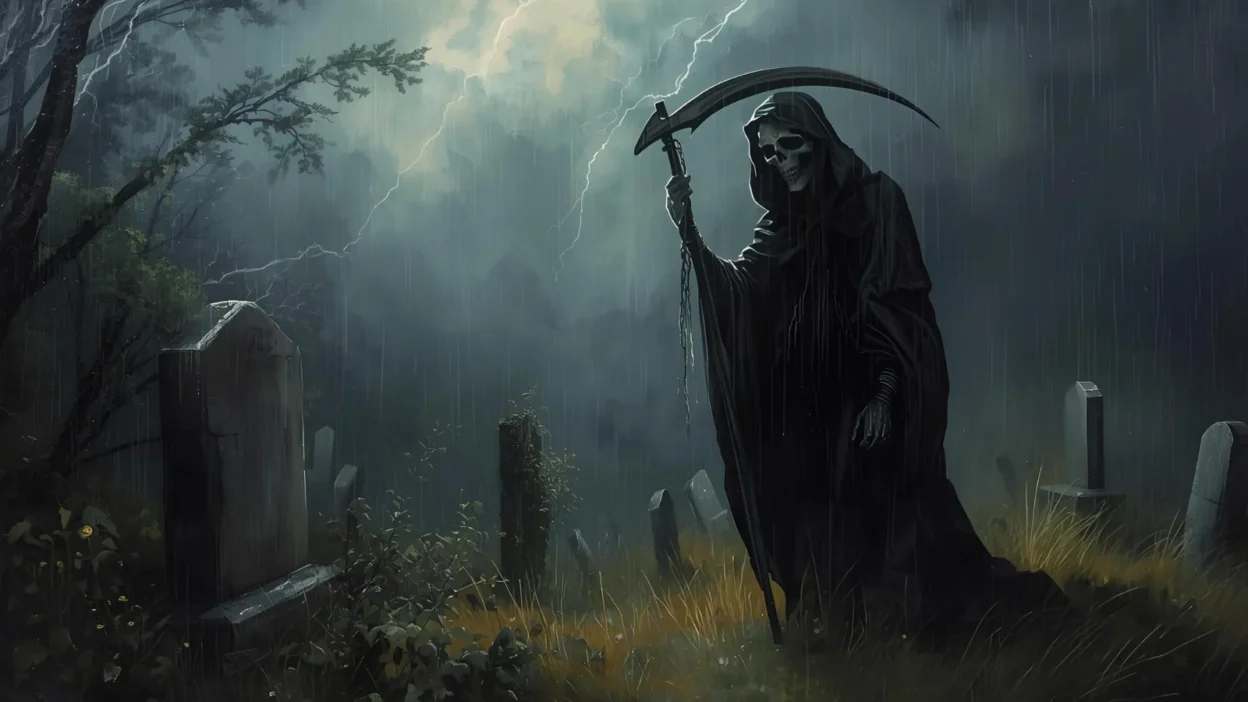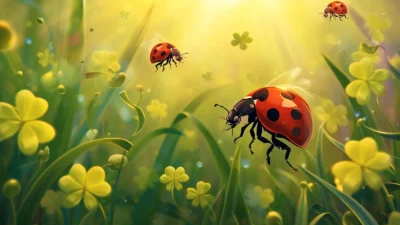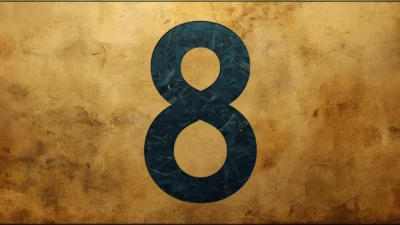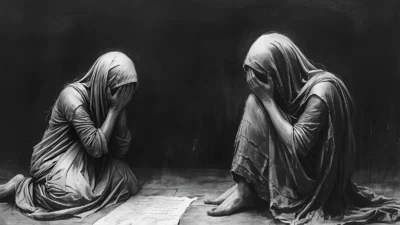Imagine walking through a quiet forest at dusk. The air feels heavy, and suddenly, you spot a black feather resting on your path. Or maybe, one night you dream of a withered rose crumbling in your hands. In moments like these, many people feel a strange mix of fear, sadness, and wonder. Could it be a sign? Could it be a symbol of death?
The spiritual meaning of seeing a symbolism of death is not always about the end of life—it often points to transformation, cycles, renewal, or the closing of one chapter so another can begin.
Across art, mythology, literature, and cultures, symbols of death carry profound messages. They can help us face our deepest fears, honor loved ones who have passed, and even embrace spiritual rebirth.
This guide will explore death symbolism in different traditions and give you real-life scenarios, practical insights, and emotional comfort so you can find meaning in these encounters.
Symbols of Death in Art
Art has always used imagery to communicate what words cannot. From paintings to sculptures, artists often rely on symbols of death to explore mortality, grief, and the passage of time.
- Skulls & Skeletons – Perhaps the most common symbol, representing both mortality and the universality of death. Renaissance art often used them to remind people of the fleeting nature of life (known as memento mori).
- Clocks & Hourglasses – Timepieces in art represent the inevitable passage of time, urging us to live with awareness and intention.
- Withered Flowers – A favorite of still-life painters, flowers fading in a vase reflect beauty, fragility, and the cycle of life.
- Dark Birds (Ravens, Crows, Owls) – Frequently painted near graves or stormy skies, birds symbolize messengers between worlds.
The spiritual meaning of seeing a symbolism of death in art is not to frighten us but to awaken appreciation for life, reminding us that every moment matters.
Symbols of Death in Mythology
Mythologies across the world use powerful imagery to describe death and the afterlife.
- Anubis (Egyptian Mythology) – The jackal-headed god guiding souls to the afterlife.
- Hades (Greek Mythology) – The ruler of the underworld, often symbolized with shadows, keys, or Cerberus, the three-headed dog.
- The Phoenix (Greek & Egyptian) – Paradoxically, the phoenix represents death through rebirth—dying in flames only to rise again.
- The Morrigan (Celtic Mythology) – A goddess of war, fate, and death, often associated with crows.
- Yama (Hindu Mythology) – The god of death who judges the departed souls.
These myths show us that death is never just an end—it is a passage, a crossing, and a transformation.
Symbolism of Death in Literature
In literature, death is symbolized not just as loss but as change, release, or the unknown.
- Winter – In poetry and novels, winter often represents endings or the silence of death.
- Darkness & Night – Used by writers to symbolize mystery, endings, and the veil between life and afterlife.
- Doors & Rivers – Crossing over thresholds or waters often represents the passage to the afterlife.
- The Rose – Both life and death are hidden in the rose’s petals—it blooms beautifully, then wilts, symbolizing love, beauty, and loss.
When you encounter these symbols, they invite reflection: What part of your life needs release so new growth can emerge?
Symbolic Symbolism of Death
Sometimes death symbols repeat across multiple cultures, creating a universal language of endings and beginnings:
- Butterflies – Though commonly seen as a sign of transformation, their short lifespan also symbolizes the fragility of life.
- Black Feathers – Often seen as omens, yet spiritually, they may represent divine protection during grief.
- Graves & Crosses – Sacred markers of memory and transition.
- Snakes – Death through shedding skin, pointing toward spiritual rebirth.
The symbolic symbolism of death highlights how humans everywhere grapple with the mystery of mortality.
Spiritual Symbolism of Death
Now, let’s focus deeply on the spiritual meaning of seeing a symbolism of death in your life.
- Endings & New Beginnings – Spiritually, death symbols often mean a cycle is closing so you can start anew.
- Shadow Work – These symbols may appear when it’s time to face fears or hidden emotions.
- Connection with the Spirit World – Some people see crows, moths, or candles extinguishing as a sign that ancestors are near.
- Awakening – Seeing death symbolism in meditation or dreams can mean your soul is evolving to higher awareness.
Rather than fearing them, think of death symbols as gentle reminders from the universe that transformation is part of life’s design.
Symbol for Death of a Loved One
When someone close passes away, the universe often communicates through symbols of death for loved ones.
- White Butterflies – Often seen after funerals, symbolizing the soul’s safe journey.
- Cardinals – Bright red birds that many believe carry messages from departed loved ones.
- Dream Visitations – Loved ones appearing in dreams with light, smiles, or gifts.
- Candles Flickering – A spiritual symbol of a presence near you.
These symbols provide comfort, closure, and reassurance that love never dies.
Greek Symbolism of Death
The Greeks gave us some of the most enduring symbols of death:
- Thanatos – The personification of peaceful death.
- Cerberus – Guardian of the underworld, symbolizing the boundary between life and death.
- The Laurel Wreath – While often for victory, it also crowned the dead, symbolizing eternal rest.
- The River Styx – A sacred river souls crossed to reach the afterlife.
In Greek culture, death was not only an ending but also a revered passage to eternal realms.
Ancient Symbols of Death
Across ancient civilizations, powerful death symbols emerged:
- The Skull – Found in Aztec rituals, Celtic carvings, and Christian art.
- Lotus Flower – In Egypt and India, it symbolized life, death, and rebirth.
- Obelisks & Tombs – Represented eternal remembrance.
- The Ouroboros (Snake Eating Its Tail) – Infinity, cycles, and death feeding life.
These ancient symbols of death still resonate today, reminding us that humanity has always sought to understand mortality.
Real-Life Scenarios
- A Feather on the Path – You’re grieving a loved one, and a black feather appears at your doorstep. It may be a spiritual sign of protection and connection.
- A Dream of Withered Flowers – You dream of roses turning to dust. This could symbolize the end of an old relationship or phase, preparing you for healing.
- A Crow Watching You – A crow lands near your window during a time of change, symbolizing guidance through transitions.
FAQs about the Spiritual Meaning of Seeing a Symbolism of Death
1. Is seeing death symbols bad luck?
Not always. Many traditions see them as guidance, transformation, or spiritual awakening rather than doom.
2. Why do I keep dreaming of death symbols?
Dreams reflect inner emotions. Death symbols may signal personal growth, release, or communication with the spirit world.
3. What animals are considered death symbols?
Crows, ravens, owls, and black butterflies are often linked with death, though they also carry meanings of wisdom and transformation.
4. How do I know if a death symbol is about my loved one?
If the symbol appears during grief—like butterflies at a funeral—it often serves as a personal sign of comfort.
5. Can death symbols mean spiritual rebirth?
Yes. Many traditions view them as signals of endings leading to powerful new beginnings.
Conclusion: Embracing Death’s Symbolism with Grace
The spiritual meaning of seeing a symbolism of death is not about fear—it’s about awakening, transformation, and eternal connection. From art to mythology, literature to real-life encounters, death symbols remind us that endings are only part of a much larger cycle.
If you are grieving, may these symbols bring you comfort and peace, showing that love and spirit never truly fade. If you are facing change, may they remind you that every ending opens the door to a new beginning.
Ultimately, death’s symbolism is not a warning—it is a whisper of hope, a reminder of life’s beauty, and an invitation to trust the journey of the soul.




